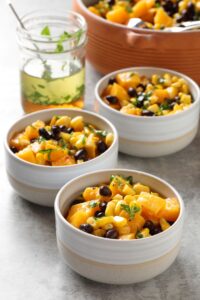Take a moment to think about the foods that are traditional to Canadians. What comes to mind? Is it poutine? Nanaimo bars? Ketchup chips? As it turns out, there is an entire category of traditional foods all around us that many Canadians have yet to discover.
 Indeed, many of our seasonal favourites – like beans, corn, potatoes, squash and tomatoes – were originally cultivated by Indigenous people. For centuries Indigenous people have used these foods, and many others, to create delicious meals that are unique to their cultures.
Indeed, many of our seasonal favourites – like beans, corn, potatoes, squash and tomatoes – were originally cultivated by Indigenous people. For centuries Indigenous people have used these foods, and many others, to create delicious meals that are unique to their cultures.
Aiming to make these recipes more mainstream, SaskCanola’s market development manager Lynn Weaver dove further into Indigenous recipes with a project that highlights ingredients grown right here in Saskatchewan. SaskCanola received project funding through the Government of Saskatchewan Agriculture Awareness Initiative Program (AAIP) under the Canadian Agricultural Partnership.
Weaver worked with an Indigenous community advisory group in Saskatchewan so that the project is meaningful, relevant and culturally appropriate.
Indigenous people have developed their own food harvesting, farming, hunting and fishing practices that have helped sustain their health and wellbeing. Knowledge of traditional foods has been passed down through generations with oral teaching, storytelling and sharing experiences.
Traditional diets consist of foods that are found in the natural environment, and often include wild game, fish and edible plants. Eating more traditional foods helps Indigenous people feel connected to their cultural identity and to other members of their community.
Historically, Indigenous people also understood the physical health benefits of a more traditional diet. They knew that eating a varied diet promotes good health. The acts of harvesting, berry picking, gardening, hunting and fishing provided additional health benefits, as well as being ways of staying physically active.
Among First Nations communities, the kinds of foods incorporated into traditional diets varies based on geographical location, availability of different plants, proximity to animal migration routes, and traditional hunting and fishing practices.
SaskCanola’s project features recipes provided by Indigenous community members that highlight Saskatchewan ingredients (and use canola oil!).
Recipes compiled for the project include Aunt Mabel’s haystack baked lentils from Métis Chef Jenni Lassard; cinnamon apple cake from Chef Jodi Robson (Okanese First Nation); cranberry, sage and puffed wild rice cookies from the mâmawi cafe (a student-run food program in north central Regina); Three Sisters salad from Indigenous Chef Kirk Ermine; wild rice salad with maple vinaigrette from Chef Douglas Hyndford (Peepeekisis Cree Nation); and savory zucchini quiche also from Chef Robson.
The six recipes are highly nutritious, versatile and combine unique flavours. For example, beans, corn and squash – known as the Three Sisters – in combination as a salad provides a balanced (and delicious) meal.
Similarly, wild rice, which is usually added to savoury dishes, is used in a re-imagined, Indigenized chocolate chip cookie recipe with cranberry and sage. Wild rice was first introduced to the northern lakes of Saskatchewan in the 1960s. Since then, the province has become the largest producer of wild rice in Canada. The recipe also uses canola oil for the added benefit of heart-healthy omega-3 fatty acids.
Over the past decade, SaskCanola has produced an extensive collection of recipes, award-winning recipe booklets and online videos to promote canola use. All recipes, complete with nutritional information, are available on the websites canolaeatwell.com and canadianfoodfocus.org.
Photo: Cranberry Sage Wild Rice Cookies
Thank you to the SaskCanola for submitting the article and photos.
